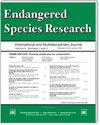Bimodal vertical distribution of right whales Eubalaena glacialis in the Gulf of St. Lawrence
IF 2.9
2区 环境科学与生态学
Q2 BIODIVERSITY CONSERVATION
引用次数: 0
Abstract
ABSTRACT: Critically endangered North Atlantic right whales Eubalaena glacialis have recently shifted their summer distribution from the Bay of Fundy to the Gulf of St. Lawrence (GSL), Canada. Entanglement in fishing gear and vessel strikes remain the main lethal threats. Foraging on deep aggregations of Calanus prey in the Bay of Fundy involves stereotyped deep ‘flat-bottom’ (U-shaped) dives, while foraging on sub-surface Calanus aggregations on the winter feeding grounds of Cape Cod Bay involves surface feeding. To explore North Atlantic right whale feeding behaviour in the GSL, 5 acoustic and biologging tags (DTAGs) were deployed using suction cups in 2019 and 2020. One whale knocked off the tag after 14 min. Diving behaviour of the other 4 whales with 2.0 to 4.7 h of data was mostly split between flat-bottom foraging dives at, or very close to, the sea floor, and near-surface activities, including logging, respirations, and potentially also sleeping. This biphasic vertical distribution not only places the whales at risk of being hit by vessels, but it may also put them at risk of coming into contact with groundlines used in various fishing industries in the GSL. Although additional research is needed as this limited dataset was restricted to hours of daylight, these results provide new information about right whale behaviour in the GSL that can help inform management actions to reduce human impacts on this endangered species.圣劳伦斯湾露脊鲸的双峰垂直分布
摘要:极度濒危的北大西洋露脊鲸 Eubalaena glacialis 最近已将其夏季分布从芬迪湾转移到加拿大的圣劳伦斯湾 (GSL)。渔具缠绕和船只撞击仍然是对它们的主要致命威胁。在芬迪湾的深海Calanus猎物群中觅食需要定型的深海 "平底"(U形)潜水,而在鳕鱼角湾冬季觅食地的海面下Calanus猎物群中觅食则需要在海面上觅食。为了探究北大西洋露脊鲸在 GSL 的觅食行为,2019 年和 2020 年使用吸盘部署了 5 个声学和生物标记(DTAG)。一条鲸鱼在 14 分钟后打掉了标签。其他 4 头鲸鱼的潜水行为(2.0 至 4.7 小时的数据)主要分为在海底或非常接近海底的平底觅食潜水和近水面活动,包括记录、呼吸和可能的睡眠。这种双相垂直分布不仅使鲸鱼面临被船只撞击的风险,而且还可能使它们面临接触到全球南部海域各种捕鱼业使用的地线的风险。尽管由于这个有限的数据集仅限于白天的时间,因此还需要更多的研究,但这些结果提供了有关大洋洲露脊鲸行为的新信息,有助于为管理行动提供信息,以减少人类对这一濒危物种的影响。
本文章由计算机程序翻译,如有差异,请以英文原文为准。
求助全文
约1分钟内获得全文
求助全文
来源期刊

Endangered Species Research
BIODIVERSITY CONSERVATION-
CiteScore
5.50
自引率
6.50%
发文量
38
审稿时长
31 weeks
期刊介绍:
ESR is international and interdisciplinary. It covers all endangered forms of life on Earth, the threats faced by species and their habitats and the necessary steps that must be undertaken to ensure their conservation. ESR publishes high quality contributions reporting research on all species (and habitats) of conservation concern, whether they be classified as Near Threatened or Threatened (Endangered or Vulnerable) by the International Union for the Conservation of Nature and Natural Resources (IUCN) or highlighted as part of national or regional conservation strategies. Submissions on all aspects of conservation science are welcome.
 求助内容:
求助内容: 应助结果提醒方式:
应助结果提醒方式:


